The biggest issues of the month explored | Energy
ENERGY
Strategy to tackle energy connection log jam
Chancellor launches plan to speed up renewables grid connections
By Thomas Johnson
Chancellor Jeremy Hunt used his 2023 Autumn Statement to announce a plan to ease the logjam in new renewable energy supplies requiring connection to the national grid.
If successful, the Connections Action Plan will ensure viable net zero aligned projects receive a connection date that is, on average, no more than six months later than the date requested.
 Connection log jam is now holding back decarbonisation
Connection log jam is now holding back decarbonisation
The measures are intended to help the UK overcome a connectivity logjam that is preventing renewable energy projects from feeding into the grid. As of October, 1,492 projects – 371GW of capacity – were queuing for connections.
A report from British Gas owner Centrica claims that 62GW of projects in the queue are “phantom” projects, which were a long way from being operational. These are holding back more developed schemes by taking up capacity for building connections.
That leaves 309GW of power generation capacity affected by the delays. The government’s plan is to tackle phantom projects and move these forward faster.
Hunt said: “These measures will cut grid access delays by 90% and offer up to £10,000 off electricity bills over 10 years for those living closest to new transmission infrastructure.”
The key measures announced are:
- Raise entry requirements to increase the quality of projects applying for transmission connections and deter speculative connection applications to speed up delivery
- Remove stalled projects from the connection ‘queue’ to release capacity for more viable projects
- Better utilise existing grid capacity to reduce connection timelines
- Move away from the first come, first served approach to allocating connection work, to one that connects projects that are readier to progress
- Improve data and processes and sharpen obligations and incentives
- Develop longer term connections process models aligned with strategic planning and market reform.
The government also set out a Transmission Acceleration Action Plan to reduce the time it takes to install low carbon electricity transmission infrastructure. At present it takes between 12 and 14 years and the action plan aims to cut this to seven.
Alongside the two action plans, the Autumn Statement included £960M funding from the Green Industries Growth Accelerator to support the expansion of UK-based green energy supply chains.
This is expected to drive the transition to net zero through financial incentives for carbon capture, utilisation and storage projects and via the development of hydrogen power, nuclear and offshore wind energy projects.
Some have questioned the extent to which the new measures will be brought into effect.
Turner & Townsend UK managing director for infrastructure James Corrigan said: “What is currently unclear is how all this will be delivered in practice. The government writes about the need for greater spatial planning of infrastructure, and the sector and ministers need to collaborate closely to assess the available resource to ensure realistic sequencing of investment and development.
“Without this we risk setting unattainable goals and hitting capacity bottlenecks in delivery.”
There was also some scepticism about an announced plan to pay households affected by new pylon installations.
Electricity software firm Neara senior vice-president Taco Engelaar said: “While some new infrastructure will be needed in the long-term – and compensating those living near to proposed power lines is a logical plan which may speed up planning processes – the reality remains that building new electricity lines is a time and labour-intensive process that could, in part, be avoided.
“We don’t need to reinvent the grid to unblock our route to clean energy. Advancements in technologies such as digital modelling and artificial intelligence are enabling us to discover ‘latent capacity’ within existing power lines. In short, we can make more of what we’ve already got. Identifying and utilising latent capacity can help us to connect more renewable energy projects to the grid and reduce the need to build new lines.”